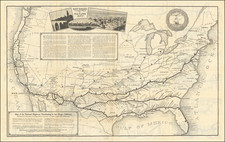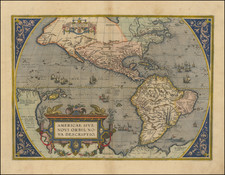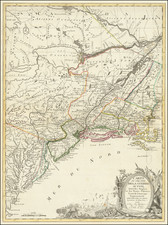The French Empire in America and the Triangular Trade
Fascinating and extremely rare map of "French America", published in Paris by Pierre Du Val and Gerard Jollain.
At the time of the original publication of Burden's Mapping of North America, Burden recorded this in his "Appendix 1 -- Lost Maps." However, by 2007, Burden had located 3 surviving examples and as of the most recent update of Burden's on-line Addenda, there are 4 surviving examples, of which 2 are believed to be in private hands.
Du Val's L'Amérique Françoise . . . offers a detailed and cartographically advanced look at the 3 regions identified by Du Val as part of "French America," (1) Nouvelle France (Canada), France Insulaire (the French Caribbean) and France Equinoctiale (Guyana). The region covered by the map strongly suggests that the map was prepared during the period the French were focused on the promotion and expansion of the colonial interests in America, as well as the French Slave Trade, which would come to be known as the Triangle Trade.
In Africa, the map covers both Senegal and the Cape Verde Islands, the region for which La Compagnie Normande held a trading monopoly beginning in the 1630s and later La Compagnie du Cap-Vert et du Sénégal held a trading monopoly from 1658 onward. In America, the three French regions referenced above were gaining momentum. The Compagnie de la France Equinoxiale had created a colony in Guyana,
The map has been colored in an early hand to indicate the location of strategically important French controlled places, primarily in Nouvelle France (Canada) and the Caribbean. For example, the place name Plaisance has been added in pen with a circle for its location and and other important locations in Canada, along with a number of Caribbean islands are identified in red. Several points on the coastline along France Equinocticale (French Guyana) are also shown.
The content of the map seems to be advanced for the period, even more so than Nicolas Sanson's maps of 1650 (North America) and 1656 (Canada). Pierre Du Val had already published a highly advanced map of Canada by 1653 (Le Canada faict par le Sr. de Champlain. ou sont La Nouvelle France . . . ) and over the next several years would publish several more maps of Canada, as well as an updated version of his 1653 map.
The map locates "Nle Suede" (New Sweden), which existed from 1638 to 1655. The treatment of the British Colonies, including the Chesapeake Region, Virginia and the Carolinas is advanced beyond Sanson's 1650 map of North America, and appears much more similar to Sanson's 1656 Le Canada ou Nouvelle France . . . , and Du Val's 1653 Le Canada faict par le Sr. de Champlain . . . . The map identifies "amestown" north of the "R. Powhawtan" in Virginia, and early reference to the Jamestown settlement. Jamestown is not shown by Sanson in either of his maps, nor is it shown identified in the same place in Duval's 1653 map. It is, however, similarly located in Duval's "L'Amerique," which Burden dates as circa 1656.
While Burden has suggested that Du Val's map is based upon Sanson's 1650 North America, with additional information drawn from other sources, our observation is that the map is significantly more advanced than Sanson's maps, especially for the Canadian content. For example, Du Val identifies the important early French settlement of Plaisance as early as 1660, whereas none of Sanson's maps (even including his 1669 map of North America) include Plaisance, all retaining information from the 1643 Boisseau map of Canada instead.
The Gerard Jollain imprint make the dating somewhat complicated. There were 2 engravers using the name Gerard Jollain in Paris, Francois Gerard Jollain (the father) and Gerard Jollain (the son). While Francois did on occasion sign in various ways other than as "Gerard Jollain," maps with the imprint of "Gerard Jollain rue St. Jacques" are known at least as early as 1655.
As discussed below, based upon the ommission of the French settlement of Plaisance from the map ( which appeared in Du Val's later maps of 1660 and 1664), as well as other relevant French Colonial activities in the region, we believe the map was likely published in the late 1650s.
Plaisance
The addition of Plaisance in manuscript suggests that the map was printed prior to the establishment of this important French setttlment and fort.
The name Plaisance does not appear on Du Val's 1653 map Le Canada faict par le Sr. de Champlain. ou sont La Nouvelle France, but is included in the 1664 second state of the map. The name Plaisance also appears on Pierre Du Val's 1660 Canada, which appeared in his Le Monde Terre. As such, it seems highly likely that the map was published in or before 1660, as it seems unlikely Du Val would omit Plaisance after 1660.
By 1662, the French established a strategic trading post at Plaisance on Newfoundland in a well protected cove overlooking Placentia Bay that separates Avalon from the rest of the island of Newfoundland, located close to Grand Banks. To protect this place, several forts were built around the cove, Fort Plaisance in 1662, Fort Royal in 1687, and Fort Saint Louis in 1690.The name Plaisance doe not appear on Sanson's map of America or his 1656 map of Canada, both of which instead show the name "Baye des Trespasses", a name which seems to have begun with Boisseau's map of 1643. Curiously, Sanson does not add Plaisance on his 1669 map of North America.
Equinoctial France
"Equinoctial France" was the name given to the part of South America between the Orinoco and Amazon River, the area which would become the Guianas. The French government granted private commerical rights to several companies in this region. The first was given to the merchants of Rouen in 1633, which in turn founded settlements at the mouth of the Cayenne River in 1634 and 1636.
In 1643, a new company was formed in Rouen called the Compagnie du cap du Nord, led by Charles Poncet de Brétigny. Poncet de Brétigny led a group of colonists to Cayenne Island, arriving in March 1644. The next year Brétigny and most of the Europeans were killed by the Caribs, and the village of Cayenne was destroyed.
The first Compagnie de la France équinoxiale was given the same privileges as the Compagnie du cap du Nord in 1651. Also known as the Compagnie de l’Amerique Equinoxial, the company recruited 800 colonists. In September 1652 the expedition reached the tip of the Pointe du Mahury on the Island of Cayenne, where they found the 25 survivors of the earlier settlement. There were violent disputes among the colonists and between them and the local Kalina people, and the colony failed, about 100 survivors fleeing to Suriname in January 1654, then to Barbados.
In 1656, the Dutch established plantations and trade in the region. The French decided to regain control, despite being at peace with the Netherlands at the time. The second Compagnie de la France équinoxiale was formed in 1663. Antoine Lefèbvre de La Barre was appointed governor of Cayenne. He left the port of La Rochelle, France in February 1664 with two warships and 400 soldiers. The expedition included 1,200 settlers. Lefèbvre arrived in Cayenne on 11 May 1664, with the Dutch general Spranger agreeing to capitulate shortly thereafter.
Lefèbvre de La Barre established a garrison at Fort Cépérou and started construction of a settlement of 200 hut and made a treaty with the indigenous people, but Successors in 1664, Louis XIV revoked all the concessions made to specific companies and created a general company for all the American colonies named the Compagnie des Indes Occidentales. The Compagnie de la France équinoxiale was merged into the Compagnie des Indes occidentales, and Lefèbvre de La Barre was recalled to take charge of the new enterprise. De la Barre became governor of Cayenne and of the Antilles, but, the English and the Dutch captured the French establishments, and it was not until 1674 that Marshall Jean II d'Estrées restored French power in Guiana. Louis XIV took all the colonies into his domain in 1674.
French Caribbean (France Insulaire)
The map shows a number of islands under French control (orange):
- Grenada: In 1649, a French expedition of 203 men from Martinique, led by Jacques Dyel du Parquet, founded a permanent settlement on Grenada, and by 1654 the island was completely subjugated by the French.
- Martinique: In 1635, Pierre Belain d'Esnambuc landed in the harbor of St. Pierre with a group of French settlers after being driven off St. Kitts by the English and claimed Martinique for the French king Louis XIII and the French "Compagnie des Îles de l'Amérique" (Company of the American Islands). In 1658 King Louis XIV took the sovereignty of the island.
- Hispanila French buccaneers established a settlement on the island of Tortuga in 1625 before going to Grande Terre (mainland Hispaniola). Although the Spanish destroyed the buccaneers' settlements several times, on each occasion they returned. The settlement on Tortuga was officially established in 1659 under the commission of King Louis XIV and by 1665 the French colony in Hispaniola was officially recognized.
- St. Kitts and Nevis: From May 13, 1627 and until July 16, 1702, the Island of St. Kitts was divided into separate English (Center) and France's Saint-Christopher.
- St. Croix: From 1651 until 1664, the Knights of Malta, ruled the island in the name of Louis XIV. The island then passed to the French West India Company.
Rarity
As noted above, the map is extremely rare.
We are unaware of any examples coming to market prior to this example being offered at auction in 2022 by Leslie Hindman.
Burden records examples at NYPL, BnF and a private German collection, along with an example in an atlas offered for sale in 2017 in France.
Pierre Duval (1618-1683) was a French geographer, cartographer, and publisher who worked in Abbeville and Paris during the seventeenth century. He was born in the former city, in northeast France, before moving to Paris. Duval was the nephew of the famous cartographer Nicolas Sanson, from whom he learned the mapmaker's art and skills. Both men worked at the royal court, having followed the royal request for artists to relocate to Paris. In addition to numerous maps and atlases, Du Val's opus also includes geography texts. He held the title of geographe ordinaire du roi from 1650 and died in 1683, when his wife and daughters took over his business.










![(American Revolution) Geschichte der Revolution von Nord-America. Sammlung der besten Schriftsteller, welche die Geschichte, besondere Rechten, Sitten, und Gewohnheiten der Völker nach ihren Grundsätzen abgehandelt haben [with map:] Die Vereinigten Staaten von Nord=America. nach der Wm. Faden 1783. [History of the Revolution of North America. Collection of the Best Writers Who Have Discussed the History, Specific Laws, Customs, and Habits of the Peoples According to Their Principles [with map:] The United States of North America. According to Wm. Faden, 1783.]](https://storage.googleapis.com/raremaps/img/small/90124.jpg)

![[ World & Continents ] Typus Orbis Terrarum / Americae Sive Novi Orbis Nova Descriptio / Asiae Nova Descriptio / Africae Tabula Nova / Europae](https://storage.googleapis.com/raremaps/img/small/99250.jpg)
![(Extremely Rare American View Book) Les Ports de l'Amerique [8 engraved prints of American Cities: Philadelphia, Boston, Savannah, Fredericksburg, Charlestown, Chesapeake Bay, Quebec, and Port Royal] Graveé d'apres le Tableau de Vernet.](https://storage.googleapis.com/raremaps/img/small/95381.jpg)
